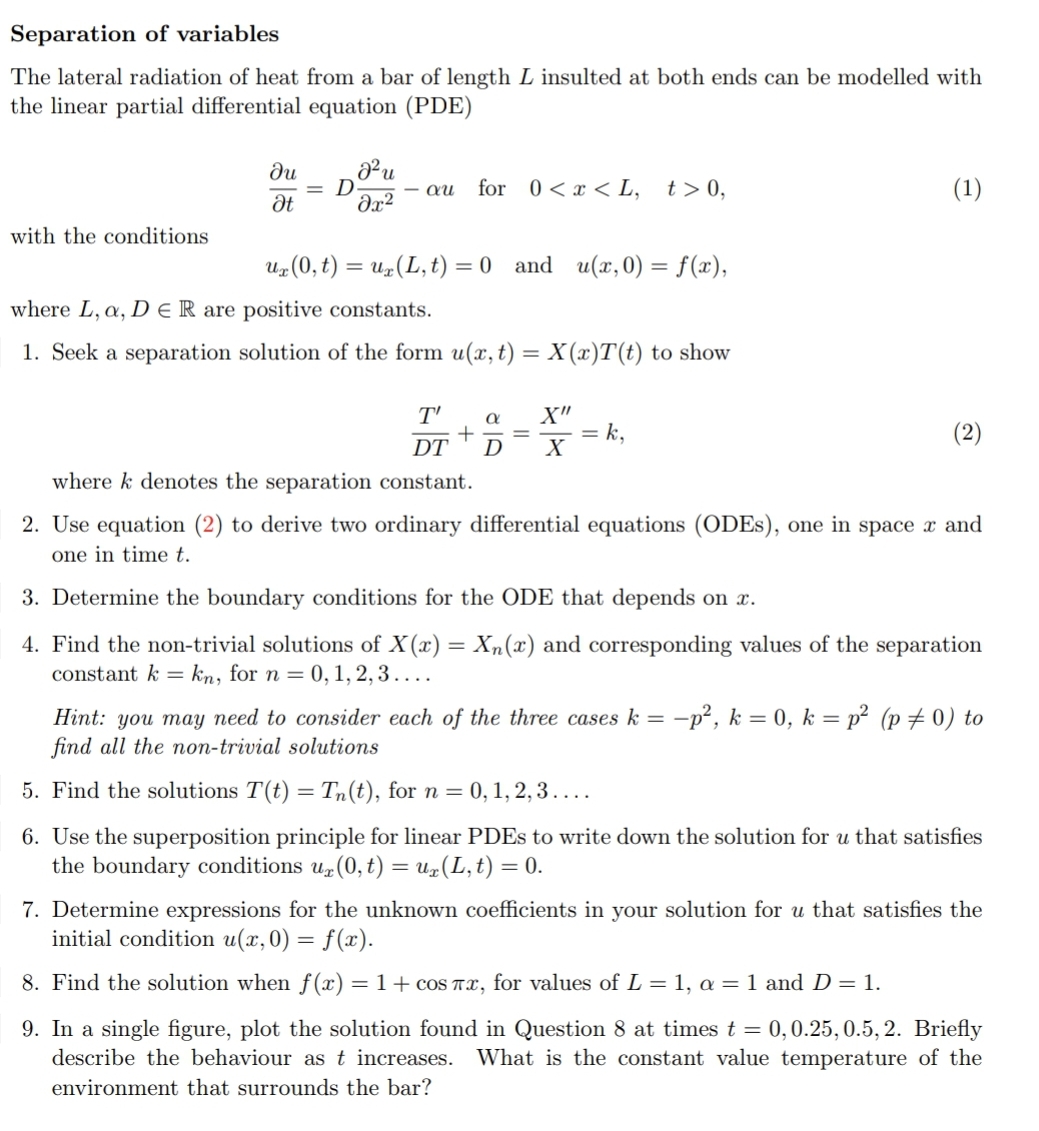Separation of variables The lateral radiation of heat from a bar of length L insulted at both ends can be modelled with the linear partial differential equation (PDE) ди 8²u = D - au for 0 0, əx² (1) Ət with the conditions uz (0, t) = ux (L, t) = 0 and u(x,0) = f(x), where L, a, DER are positive constants. 1. Seek a separation solution of the form u(x, t) = X(x)T(t) to show T' a + X" = k, (2) DT D X where k denotes the separation constant. 2. Use equation (2) to derive two ordinary differential equations (ODES), one in space x and one in time t. 3. Determine the boundary conditions for the ODE that depends on x. 4. Find the non-trivial solutions of X(x) = Xn(x) and corresponding values of the separation constant k = kn, for n = 0, 1, 2, 3 .... Hint: you may need to consider each of the three cases k = -p², k = 0, k = p² (p = 0) to find all the non-trivial solutions 5. Find the solutions T(t) = Tn(t), for n = 0, 1, 2, 3 .... 6. Use the superposition principle for linear PDEs to write down the solution for u that satisfies the boundary conditions u₂(0, t) = ux (L, t) = 0. 7. Determine expressions for the unknown coefficients in your solution for u that satisfies the initial condition u(x,0) = f(x). 8. Find the solution when f(x) = 1 + сos лx, for values of L = 1, a = 1 and D = 1. 9. In a single figure, plot the solution found in Question 8 at times t = 0, 0.25, 0.5, 2. Briefly describe the behaviour as t increases. What is the constant value temperature of the environment that surrounds the bar?
Separation of variables The lateral radiation of heat from a bar of length L insulted at both ends can be modelled with the linear partial differential equation (PDE) ди 8²u = D - au for 0 0, əx² (1) Ət with the conditions uz (0, t) = ux (L, t) = 0 and u(x,0) = f(x), where L, a, DER are positive constants. 1. Seek a separation solution of the form u(x, t) = X(x)T(t) to show T' a + X" = k, (2) DT D X where k denotes the separation constant. 2. Use equation (2) to derive two ordinary differential equations (ODES), one in space x and one in time t. 3. Determine the boundary conditions for the ODE that depends on x. 4. Find the non-trivial solutions of X(x) = Xn(x) and corresponding values of the separation constant k = kn, for n = 0, 1, 2, 3 .... Hint: you may need to consider each of the three cases k = -p², k = 0, k = p² (p = 0) to find all the non-trivial solutions 5. Find the solutions T(t) = Tn(t), for n = 0, 1, 2, 3 .... 6. Use the superposition principle for linear PDEs to write down the solution for u that satisfies the boundary conditions u₂(0, t) = ux (L, t) = 0. 7. Determine expressions for the unknown coefficients in your solution for u that satisfies the initial condition u(x,0) = f(x). 8. Find the solution when f(x) = 1 + сos лx, for values of L = 1, a = 1 and D = 1. 9. In a single figure, plot the solution found in Question 8 at times t = 0, 0.25, 0.5, 2. Briefly describe the behaviour as t increases. What is the constant value temperature of the environment that surrounds the bar?
Related questions
Question
please send complete handwritten solution

Transcribed Image Text:Separation of variables
The lateral radiation of heat from a bar of length L insulted at both ends can be modelled with
the linear partial differential equation (PDE)
Ju
² u
= D.
- au for 0<x<L, t> 0,
(1)
Ət მე2
with the conditions
ux(0, t) = ux (L, t) = 0 and u(x,0) = f(x),
where L, a, DER are positive constants.
1. Seek a separation solution of the form u(x, t) = X(x)T(t) to show
T' a X"
+ = = k,
(2)
DT D X
where k denotes the separation constant.
2. Use equation (2) to derive two ordinary differential equations (ODEs), one in space x and
one in time t.
3. Determine the boundary conditions for the ODE that depends on x.
4. Find the non-trivial solutions of X(x) = Xn(x) and corresponding values of the separation
constant k = kn, for n = 0, 1, 2, 3....
Hint: you may need to consider each of the three cases k=-p², k = 0, k = p² (p = 0) to
find all the non-trivial solutions
5. Find the solutions T(t) = Tn(t), for n = 0, 1, 2, 3 ....
6. Use the superposition principle for linear PDEs to write down the solution for u that satisfies
the boundary conditions ur (0, t) = u(L, t) = 0.
7. Determine expressions for the unknown coefficients in your solution for u that satisfies the
initial condition u(x,0) = f(x).
8. Find the solution when f(x) = 1 + cos πx, for values of L = 1, a = 1 and D = 1.
9. In a single figure, plot the solution found in Question 8 at times t = 0, 0.25, 0.5, 2. Briefly
describe the behaviour as t increases. What is the constant value temperature of the
environment that surrounds the bar?
Expert Solution
This question has been solved!
Explore an expertly crafted, step-by-step solution for a thorough understanding of key concepts.
Step by step
Solved in 3 steps with 3 images
